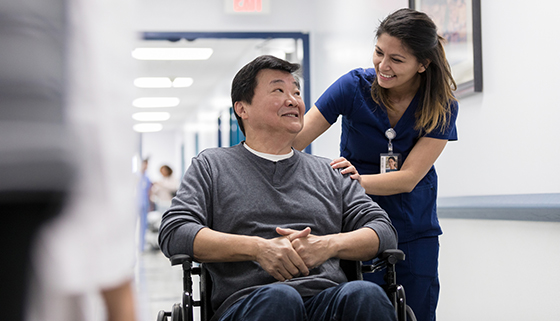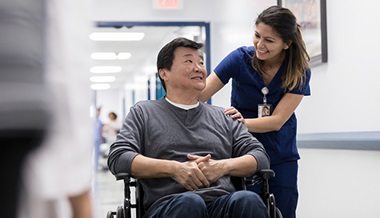Transradial Cardiac Catheterization
What is transradial cardiac catheterization?
Transradial cardiac catheterization is a procedure used to treat and diagnose certain heart conditions. It is also known as transradial cardiac cath or angiography.
During the procedure, a healthcare provider inserts a long thin tube (catheter) through the radial artery. The radial artery is a blood vessel in the arm. He or she then threads this tube through the blood vessels all the way to the heart with the help of special X-rays. This tube may have various tools attached to it, depending on the reason for the procedure. For example, the healthcare provider may put a special dye inside the catheter to take X-ray pictures of the arteries in your heart. The catheter might have a balloon attached to it. This catheter and balloon help open up blockages in your heart’s arteries.
Why might I need transradial cardiac catheterization?
There are many reasons you might need this procedure. You may need it if you are having chest pain. The procedure can show whether the heart’s arteries have become blocked because of coronary artery disease. It also helps your healthcare provider determine a treatment plan. This test is called coronary angiography.
If you have a known blockage in a coronary artery, you may need a cardiac catheterization using a technique called coronary angioplasty. Your provider attaches a balloon to the tip of the catheter. When the balloon is in place, it is inflated and presses the plaque to the side of the blood vessel. That increases blood flow through the artery. A stent is often placed at the blockage site to keep the vessel open.
Healthcare providers also use cardiac catheterization to do other procedures on the heart. For example, they can use it to open a narrowed heart valve. It is less invasive than open heart surgery.
If you need cardiac catheterization, your healthcare provider may recommend the transradial type. The transradial approach may have a mildly lower risk for complications compared with the method that goes through a blood vessel in the leg (transfemoral). Your recovery may be shorter and easier as well when compared to the transfemoral approach. Not all surgical centers use this type of cardiac catheterization regularly. Ask your healthcare provider if it might make sense for you.
What are the risks of transradial cardiac catheterization?
In general, the risks of this procedure are low. Some may be even lower using the transradial approach. Possible complications include:
- Abnormal heart rhythms
- Puncturing the heart or coronary arteries
- Allergic reactions
- Blood clot. This can lead to stroke or other problems.
- Kidney failure
- Infection
- Excess bleeding
- Pain and swelling at the catheter insertion site
- Nerve damage to the wrist and hand
- Damage to blood vessel supplying the wrist and hand
- Death (very rare)
Your own risks may differ based on your age, your health problems, and the reason for the procedure. Ask your healthcare provider about your specific risks.
How do I get ready for transradial cardiac catheterization?
Ask your healthcare provider about how to get ready. You should not eat or drink anything after midnight before the day of the procedure. You may also need to stop taking certain medicine beforehand.
Your healthcare provider may want some extra tests before the procedure. These might include:
- Chest X-ray
- Electrocardiogram, to look at heart rhythm
- Blood tests, to check general health
- Echocardiogram, to look at heart anatomy and blood flow through the heart
An IV will be placed in your hand or arm before the procedure starts. Any hair from the area around the catheter insertion may be removed. You may get medicine to help prevent blood clots.
What happens during transradial cardiac catheterization?
Talk with your healthcare provider about what to expect. The specific details of the procedure may vary based on the reason for it. In most cases, a cardiologist and a team of specialized nurses will do the procedure in a cardiac catheterization lab. In general:
- You will get medicine to make you sleepy. But you will be awake during most types of cardiac catheterization. Sometimes the procedure happens under general anesthesia.
- During the procedure, the medical team will carefully watch your vital signs.
- The blood flow in the wrist and hand will be assessed before the procedure.
- A numbing medicine will be injected into your arm to numb the spot where the catheter will be placed.
- The healthcare provider will use a needle to reach the blood vessel in the arm. Rarely is dissection with surgical tools required.
- The provider puts a thin wire into the blood vessel and threads it all the way to the heart.
- Using the wire as a guide, the provider puts the catheter over the wire. The provider then moves the catheter all the way to the heart. Then the wire will be removed.
- The provider may use X-ray images and echocardiogram to see exactly where the catheter is.
- Using the catheter, the healthcare provider will do the next steps of the procedure. For example, he or she opens up a blocked coronary vessel.
- Once the procedure is done, the catheter is removed through the blood vessel.
- The catheter insertion site will be closed and bandaged. Medical staff will put pressure on the site for a time to prevent bleeding.
What happens after transradial cardiac catheterization?
Ask your healthcare provider about what to expect after the procedure. Your healthcare provider may have specific instructions based on the reason for why you are having it. In general:
- You may be groggy and disoriented for a while.
- Your heart rate, breathing, blood pressure, and oxygen levels will be closely watched.
- You will feel some soreness. But you shouldn’t feel severe pain. Pain medicine is available if needed.
- Your healthcare provider might give you medicine to keep your blood from clotting if a heart artery was opened or stent deployed.
- Your healthcare provider may order follow-up tests such as an electrocardiogram or an echocardiogram.
- If your condition is stable, you may be able to go home the day of the procedure. If so, you will need to have someone drive you home.
After you leave the hospital:
- Ask what medicine you need to take. You may temporarily need to take antibiotics or medicines to prevent blood clots. Take pain medicines as needed.
- You can resume your normal activities fairly quickly. But avoid strenuous activities and heavy lifting for several days.
- Be sure to keep all follow up visits.
- Call your healthcare provider if you have increased swelling, chest pain, increased bleeding or drainage, a fever, or severe symptoms.
- Follow all the instructions your healthcare provider gives you about medicine, exercise, diet, and wound care.
Next steps
Before you agree to the test or the procedure make sure you know:
- The name of the test or procedure
- The reason you are having the test or procedure
- What results to expect and what they mean
- The risks and benefits of the test or procedure
- What the possible side effects or complications are
- When and where you are to have the test or procedure
- Who will do the test or procedure and what that person’s qualifications are
- What would happen if you did not have the test or procedure
- Any alternative tests or procedures to think about
- When and how will you get the results
- Who to call after the test or procedure if you have questions or problems
- How much will you have to pay for the test or procedure




